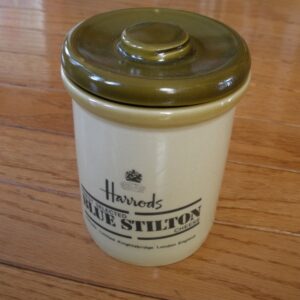For sale is a rare early 1900s SWIFT’S ARSENATE OF LEAD STONEWARE JAR from the Merrimac Chemical Company, Boston, MA. This crock has a striking company logo that reads “Swift’s Arsenate of Lead – 5 Lbs – Manufactured Only By The Merrimac Chemical Co., Boston, U.S.A.” The crock’s shoulders have raised embossed text: “POISON”. Jar has no chips or cracks and is in excellent shape. The jar has a wire handle with a wooden handle. Jar stands 6 1/2 inches tall (not including the handle) with a 5 1/2 inches diameter. A terrific advertising stoneware collectible from an American polluter.
Arsenate of Lead was first used as an insecticide when it was introduced in 1898 against the gypsy moth in Massachusetts. It also adhered better to the surface of the plants than other insecticides, further enhancing and prolonging its insecticidal effect. It was used mainly on apples, but also on other fruit trees, garden crops, turfgrasses, and against mosquitoes. In the early 20th century, it was the most popular pesticide.
In the year 1929, almost 30 million pounds of lead arsenate and calcium arsenate were spread across this country’s fields and orchards.
During a 1935, weekly radio program sponsored by the U.S. Food and Drug Administration, the host suggested that the old-time school rhyme “A is for Apple” be changed as follows: “A is for Arsenate – Lead if you please – Protector of Apples – Against Archenemies.
In 1853, the Woburn Chemical Works was founded. In 1853, the company was renamed the Merrimac Chemical Company. Woburn’s chemical and dye manufacturing industries substantially increased production throughout the second industrial revolution. Between 1853 to 1931, the Merrimac Chemical Company and other manufacturers of arsenic-based insecticides, sulfuric acid, phenols, TNT, and chemicals for the leather-tanning industry occupied this area of Woburn. Between 1899 and 1914, the Merrimac Chemical Company had grown to become the largest producer of arsenic-based pesticides in the country. The careless disposal by Merrimac Chemical of the wastes from their manufacturing processes gravely impacted surrounding communities. Scientists estimated that between 1888 to 1929, between 200 and 900 metric tons of arsenic were released into the surrounding ecosystem as a result of pesticide and sulfuric acid manufacturing activities. In 1929, Merrimac Chemical was
acquired by the Monsanto chemical company.
acquired by the Monsanto chemical company.












